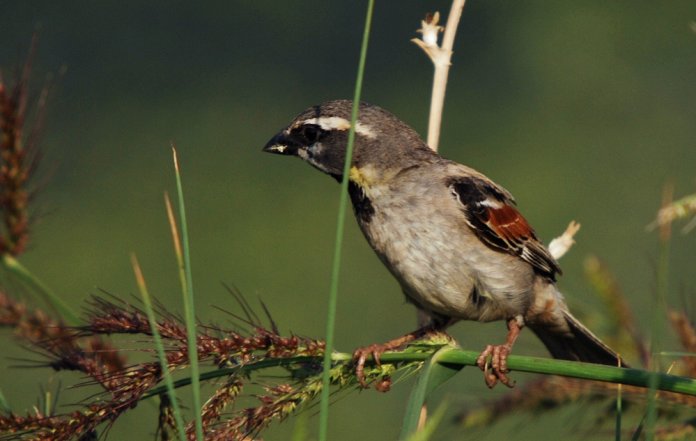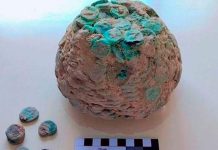IDENTIFICATION
Dead Sea Sparrow ‘Passer moabiticus’ is small 12 cm in length and a very localized sparrow of the Middle East. Dead Sea Sparrow is markedly smaller and daintier than House or Spanish Sparrows, with smaller bills and shorter wings. Primary projection reduced, with just three primary tips visible beyond tertials (4–5 in House and Spanish).
The adult male summer has gray crown, ear-coverts, and nape, contrasting with fairly small and well-defined black bib, black lore, and bill, whitish sub-moustachial stripe that merges with a yellowish-buff patch on the side of the neck and whitish supercilium (which becomes yellowish-buff behind the eye).
Median and greater coverts are chestnut, contrasting with black lesser coverts with narrow white tips that form a narrow wing bar (often concealed). Unlikely to be confused an adult male winter in fresh plumage in autumn has horn-colored lower mandible and pale feather fringes partly obscure gray on the head and black bib, while the yellow patch on the neck is less conspicuous, so more care is required.

The adult female and juvenile resemble adult female/juvenile House Sparrow but are markedly smaller and neater with a ‘sweeter’ appearance owing to the relatively slightly larger head and smaller bill. They look paler overall, with sandy-gray upperparts and paler underparts (typically showing a buffish suffusion on flanks).
The supercilium is more clearly defined both above and behind the eye than in House and is tinged with cinnamon-buff behind the eye in fresh plumage in autumn. Regularly show more contrast between the whiter throat and grayish-brown breast and more contrasting, well-defined markings on the mantle. Dead Sea Sparrow is a sociable species, non-breeders forming dense flocks in waterside bushes.
The bird is very shy and wary, flocks flying off considerable distances when disturbed. Typically mixes with migrant Spanish Sparrows. Loosely colonial, building individual nests in waterside bushes. On the other hand, birds in female-type plumage have wing lengths up to 68 mm; both Spanish and House Sparrows normally have wing lengths of over 70 mm.
SEX/AGE
Juvenile resembles adult female; as respective adults by the first winter but young males typically a little duller and less distinctly patterned.
VOICE
Dead Sea Sparrow call is a usual short, high-pitched two-or three-syllable chirp (higher-pitched than the equivalent call of House Sparrow); ‘chip-chew’ or ‘chip-chip-chew’. Dead Sea Sparrow song is distinctive, uttered from proximity to the nest, a repeated, high, rhythmic, rather shrill ‘chilling-chilling-chilling’ or ‘dli-dli-dli’, quite unlike the chirping of commoner sparrow species.
STATUS/HABITAT
Dead Sea Sparrow is very localized but quite numerous at some sites. Resident at some sites in Israel and Iraq but other breeding populations are summer visitors. (In addition to mapped range, has bred Cyprus.) The winter distribution is imperfectly known. The waterside trees, thickets, or scrub (sometimes amidst reed beds) in arid country, with a special liking for tamarisks.







